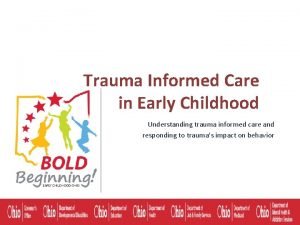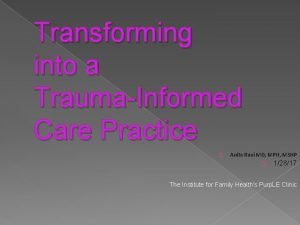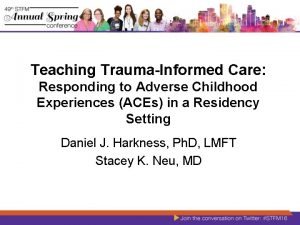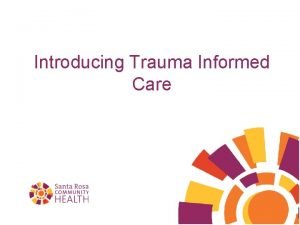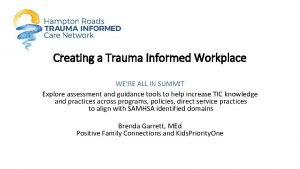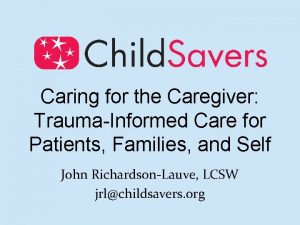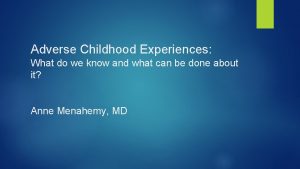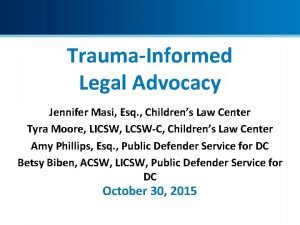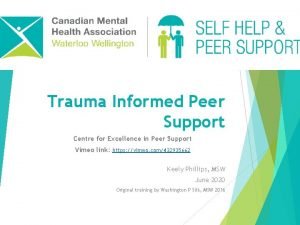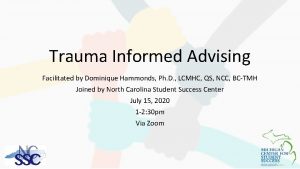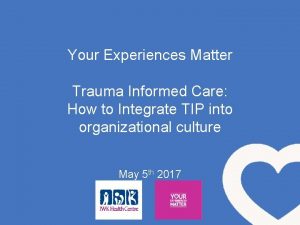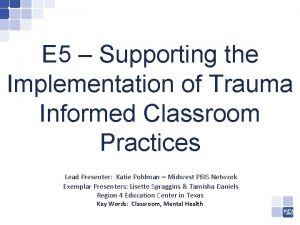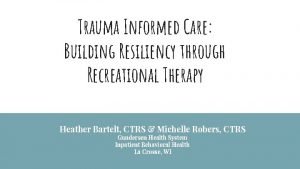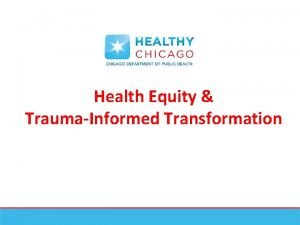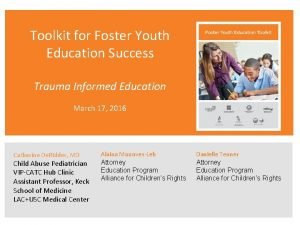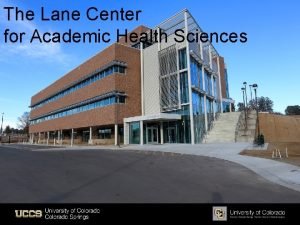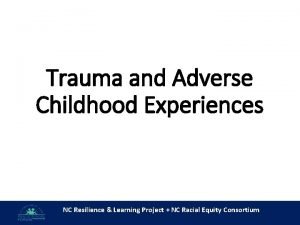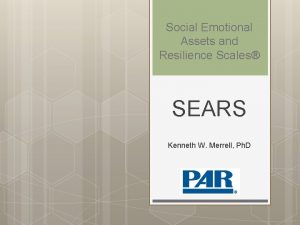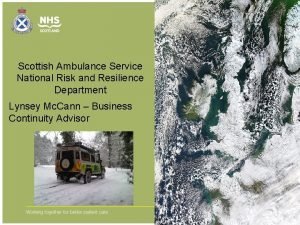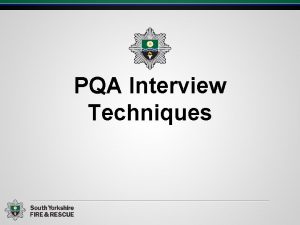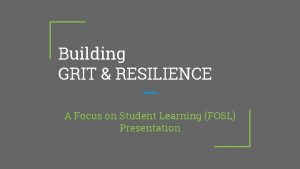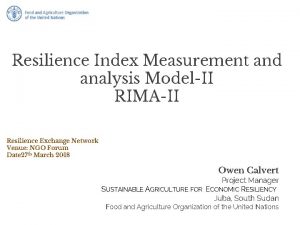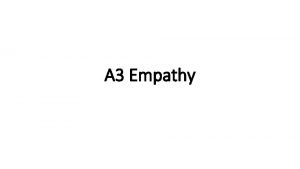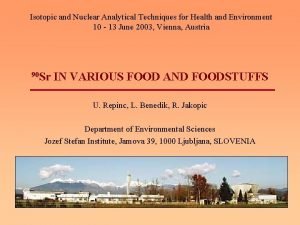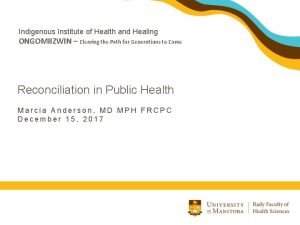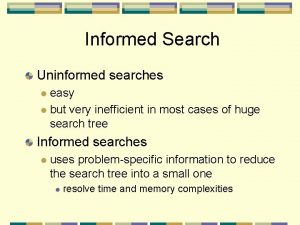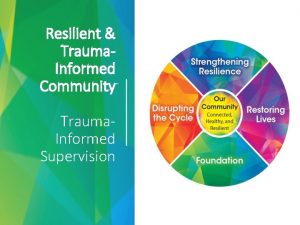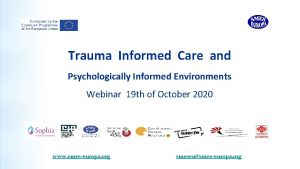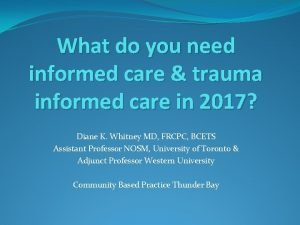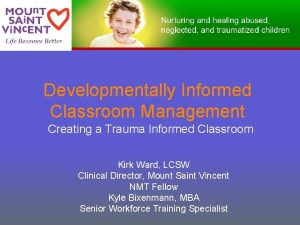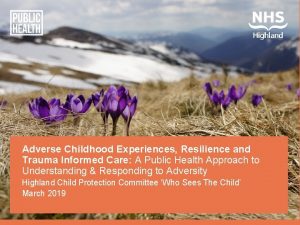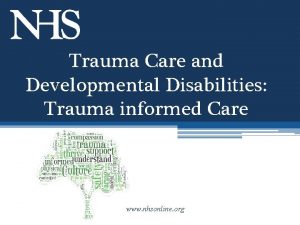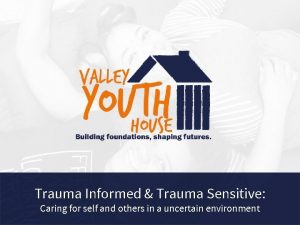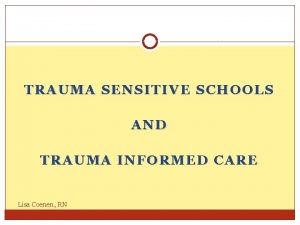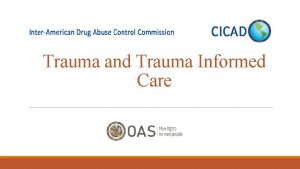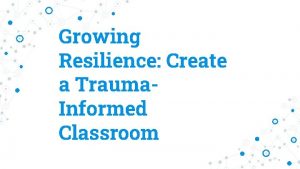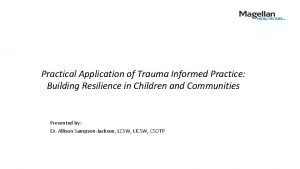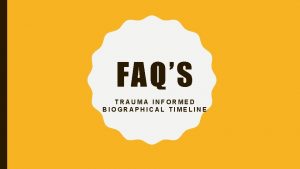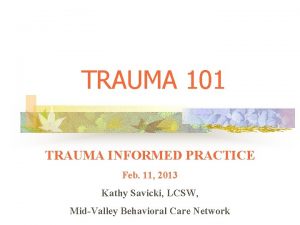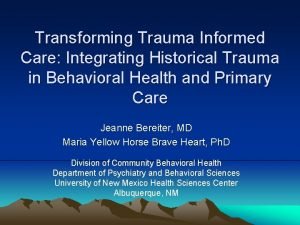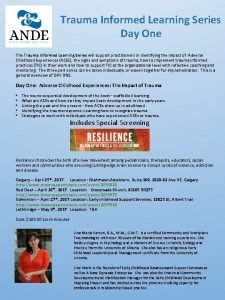Institute for Resilience Health and Justice Trauma Informed






































- Slides: 38

Institute for Resilience, Health, and Justice Trauma Informed Enhancing Resilience Systems of Care ° Andrew Hsi, MD, MPH Director of Institute for Resilience, Health, and Justice

Why This Might be Important The audience will: • Relate trauma from toxic stress to health problems and legal outcomes • Connect adverse childhood experiences (ACEs) to toxic stress • Connect the FOCUS medical home model to prevention of ACEs and toxic stress • Explore research opportunities in the institute • Explore new systems of care that enhance resilience

“The overtly simplistic explanations of human behavior that guide so many organizational and political decisions regularly fail to take into account one of the most important determining factors in human experience – the presence throughout human history of exposure to overwhelming, repetitive, multigenerational traumatic experiences and the potentially negative impact of those experiences on individual, group and political processes. ” Bloom, S. S. (2006). Neither liberty nor safety: The impact of of fear on on individuals, Bloom, institutions, and societies, part IV. Psychotherapy and Politics International, 4 -23. institutions, Retrieved January 16, 2015.

Trauma Informed Approach • According to SAMHSA’s concept of a trauma-informed approach, “A program, organization, or system that is trauma-informed: • Realizes the widespread impact of trauma and understands potential paths for recovery; • Recognizes the signs and symptoms of trauma in clients, families, staff, and others involved with the system; • Responds by fully integrating knowledge about trauma into policies, procedures, and practices; and • Seeks to actively resist re-traumatization. "

Effects of Trauma and Toxic Stress • High levels can alter the course of a life • Without treatment trauma can interfere with – Emotional well-being – Physical and cognitive health and – Interpersonal relationships. • Change the way people – View the world – Experience systems of care around them • React to additional stresses like illness

Events Occur in the Context of Community Traumatic and adverse experiences occur – – – Chronically or in isolation Homes Workplaces Schools Community • Individuals and communities experience trauma – Neighborhood violence, pervasive poverty – Shared experiences of oppression, racial discrimination – Injustice, unequal protection by laws

Interventions Can Help Individuals • Reduce trauma-related symptoms – PTSD – Anxiety and depression • To address trauma at a community level: – Trauma-informed care practices • • Health systems Schools Criminal justice Community organizations

2 Main Goals for Trauma-Informed Practices • Prevent and discourage: – Replication and reenactment of dysfunction related to complex multigenerational trauma, – Both individuals and communities • Improve the quality of life for communities – More comprehensive understanding of • Human experience and • Behavior

Trauma Including Adverse Childhood Experiences Create Toxic Stress ° Prevalence in US Studies

Prevalence of Trauma in US • 89% of adults have experienced >1 in lifetime – DSM-5 criterion-level traumatic events – Events include experiences such as • “witnessing dead bodies unexpectedly, ” • “death of a family member/ close friend due to – Violence – Accident – Disaster • Limited aid to resolve suffering, recurring images

Traumatic Experiences for Children • 2014 study estimates 48% have had 1 of 9: – “Extreme economic hardship” and – “Witnessing neighborhood violence, ” or – “Being the victim of neighborhood violence” • 30. 7% kids in Baltimore City have experienced >2 ACEs – The state of Maryland at 19. 4% of children – Nationally at 22. 6% of children Bethell, C. , Newacheck, P. , Hawes, E. , & Halfon, N. (2014). Adverse childhood experiences: Assessing the impact on health and school engagement and the mitigating role of resilience.

Study of ACEs Data by Kaiser Permanente and CDC • Evaluation at Kaiser Health Appraisal Clinic – 50, 000 patients evaluated annually – Over every 4 years, 81% HMO members seen – Medical, psychosocial, preventive evaluations • Sent survey of general health risk factors – 68% response rate of all patients evaluated – Survey questions included ACEs questions • 17, 337 of 18, 175 completed mailed survey – Average of those completing surveys was 56 years Felitti, Anda, et al. , 1998 and http: //www. cdc. gov/ace/prevalence. htm

Abusive Adverse Childhood Experiences • Child psychological abuse 11% • Child physical abuse 28% • Child sexual abuse 22%

Child Raised in A Home Environment With: • • • Family member as alcoholic or drug abuser: 27% Family member mentally ill or suicidal: 19% Violence directed against the child’s mother: 13% Family member imprisoned: 5% Loss of biological parent: 22%

Summary of ACEs in Study 1. 2. 3. 4. 5. 6. Childhood psychological abuse Childhood physical abuse Childhood sexual abuse Family member abused alcohol or drugs Loss of biological parent Family member mentally ill or suicidal 8. Family member imprisoned 11% 22% 26% 22% 19% 13% 4% • Parents ever separated or divorced 23% 7. Violence directed against the child’s mother

Adverse Experiences and Adult Alcoholism 18 % Alcoholic as Adult 16 >4 14 12 10 2 3 8 6 1 4 2 0 0 Numbers of Adverse Childhood Experiences

Relative Risks of Health Behaviors Associated with Risks for Early Death ACE score Alcoholism IV Drug Abuse Attempted Suicide 0 1. 0* 1 1. 9 1. 0 1. 8 2 2. 1 2. 5 4. 0 3 2. 7 3. 5 4. 0 4 4. 5 3. 8 7. 2 ≥ 5 5. 1 9. 2 16. 8 * 0 adverse events set as standard risk of 1. 0

More Risk Behaviors Associated with ACEs • >4 ACEs had risks 2 to 10 -fold greater than 0 ACEs – Pregnant as teen, fathering as teen – Depression – Smoking and lung disease – Lack of physical activity – Poor health by self-evaluation • Additional burden from behaviors or adverse events of adulthood not described or known 18

Percent who impregnated a teenage girl Likelihood of Impregnating a Teen Girl by Age of Sexual Abuse of Males Not abused 16 -18 yrs 11 -15 yrs Age when first abused < 11 yrs

Normal Life Course Death End of Life Health Status Adoption of Health Behaviors Social, Emotional, & Cognitive Skills Optimal Neurodevelopment Childhood Experiences Birth

Illustration of ACEs on Risks Behaviors and Health Death Early Death Disease, Disability Not every person goes through each step and the progression becomes interrupted Adoption of Health-risk Behaviors Social, Emotional, & Cognitive Impairments Disrupted Neurodevelopment Adverse Childhood Experiences Birth

Our challenge….

How do our kids go from here…. to here…. . and end up here, or here? dailymail. uk/wakingtimes. com/en. wikipedia. org

In addition to poor health outcomes… …children who suffer trauma and experience emotional challenges also face poor social/legal outcomes.

Many Kids who Experiences ACEs will also Develop Emotional Disturbance or Mental Health Problems • Compared to those with other disabilities § Likely to end up in foster care § Almost twice as likely to become teenage mothers § >3 times as likely to be arrested before leaving school § The lowest graduation rate only 35% graduate § Compared to 76% for all students graduating § 73% of drop outs are arrested within five years

What Does the Future Predict § 2 x as likely to be living in a § § Correctional facility Halfway house Drug treatment center or On the street after dropping out of school If kids with ED are more likely to end up in foster care, to be teen parents, to interact in the juvenile justice system, and/or to risk dropping out of high school, what does that mean for their future?

Institute for Resilience, Health, and Justice Research Opportunities in Development ° In Collaboration with George Davis, lead psychiatrist YDDC Prof. Yael Cannon, UNM Law School Andy Bochte, Esq, research assistant New Mexico Sentencing Commission Linda Freeman and Amir Chapel, Institute for Social Research

NM Sentencing Commission YDDC Study is Only Study of NM Youth • Children Youth and Families Department (CYFD) – Juvenile Justice Services (JJS), Psychiatric Services – 220 juveniles – Summarized collateral information • • • educational, medical, protective services, psychological testing and treatment, legal, and juvenile probationary data

Types of ACEs Identified Psychological Abuse 58% Physical Abuse Sexual Abuse Emotional Neglect Physical Neglect Divorce/Separation Intimate Partner Violence Substance abuse/Prenatal substance exposure 52% 27% 76% 94% 86% 55% 80% Family member incarcerated 56%

Juveniles with High Numbers of ACES • • • Mean for 220 juveniles 5. 3 ACEs 21 (9. 5%) had 8 ACEs 52 (23. 6%) had 7 36 (16. 4%) had 6 109/220 (49. 5%) had 6 or more ACEs

Relative Risks of Health Behaviors Associated with Risks for Early Death ACE score Alcoholism IV Drug Abuse Attempted Suicide 0 1. 0* 1 1. 9 1. 0 1. 8 2 2. 1 2. 5 4. 0 3 2. 7 3. 5 4. 0 4 4. 5 3. 8 7. 2 ≥ 5 5. 1 9. 2 16. 8 Youth at YDDC have Greater risk for alcoholism, IV drug use, suicide

Mental Illness and ACES Excluding ODD, conduct disorder, PDD, and SA • 100% with >8 had axis 1 diagnoses • 85% with >7 • 94% with >6 • 107/109 (98%) had substance use disorders • Suicidality – 20% had attempted suicide – 26% had injured themselves

Health Risk Behaviors and Criminal Justice System Involvement NM 853 inmates incarcerated for drug possession About 85% of all offenders have substance abuse problems 44 – 62% of probationers test positive for drugs in any month AZ Supreme Court found 77% of drug offenders got clean as a result of the treatment • Females < 18 years involvement in delinquency – connected to conflicts in familial and social relationships – have histories of physical, emotional and sexual abuse – suffer from physical and mental disorders • • Levin MA, Rio Grande Foundation, 2013 New Mexico Sentencing Commission Data Report: An Overview of the Juvenile Justice And Criminal Justice Systems, 2005

NM Sentencing Commission Study Kaiser Prevalence Rates in Parentheses • 2010 study of prisoners at NM Women’s Correctional Facility • Much higher ACEs prevalence than original Kaiser study • 71. 4% had substance abuse in household (29. 5%) • 51% had experienced sexual abuse (24. 7%) • 45. 2% had experienced family violence (13. 7%) • 38. 1% had 5 or more ACEs (12. 5%) 34

ACEs Study of Incarcerated Native American Women in NM (2008) • Incarcerated, self-identified AI/Alaska Native women at NM Women’s Correctional Facility • All but one woman had at least one ACE • 81% had at least two ACEs • 83% had attempted suicide at least once • 90% of those who were incarcerated on drug/alcohol offenses had been arrested before for the same reason 35

The Life Course Impact of Social-Legal ACEs Death End of Life Legal Status; access to social benefits Early Death Adoption of Citizen Behaviors; agency as individual legal entity Potential Limited Social Benefits; Isolation Adoption of legal-risk Behaviors; limitations of rights Social, Emotional, & Cognitive Skills; participatory citizenship Social, Emotional, & Cognitive Impairments; obstacles to participation Optimal Neurodevelopment; Security Disrupted Neurodevelopment Experience of toxic stress, unequal application of the law Childhood Experiences Adverse Childhood Experiences Equal protection under the law Dominant culture exerts control on victims of ACEs Birth

Organization Chart for IRHJ Director, Andy Hsi, 0. 4 FTE Reporting to Executive Vice Chancellor, HSC Admin Asst 0. 5 FTE TBN Corinne Wolfe Center for Family and Children’s Justice, Law School Manager of office location TBD Director of Educational Activities Sally Bachofer, MD, 0. 2 FTE Undergrad, Grad Andy Hsi, Co-Faculty Director of Clinical Systems Development, Andy Hsi High Risk Youth Medical Home Melanie Baca, , MD Social Worker, 1. 0 FTE TBN Home Visitor Service Coordinators, 2. 0 FTE TBN Director of Research Activities, Andrew Sussman, Ph. D, 0. 1 FTE Sherry Weitzen, MD, 0. 2 FTE Heather Pratt-Chavez, MD, 0. 1 FTE

Recommendations by SAMHSA for providers caring for survivors of trauma • • • Work with the client to learn the cues he or she associates with past trauma. Obtain a good history. Maintain a supportive, empathetic and collaborative relationship. Encourage ongoing dialogue. Provide a clear message of availability and accessibility throughout treatment. Take appropriate measures after someone has a traumatic injury or accident to reduce stress and address needs beyond immediate medical care. Avoid institutional policies such as seclusion and restraint that are likely to retraumatize individuals who have trauma histories. Provide a safe and secure environment. Advocate for appropriate coordination among services.
 4 r's trauma informed care
4 r's trauma informed care Lgbtq trauma informed care
Lgbtq trauma informed care 4 r's trauma informed care
4 r's trauma informed care Trauma informed approach
Trauma informed approach Trauma informed icebreakers
Trauma informed icebreakers Trauma-informed workplace checklist
Trauma-informed workplace checklist Trauma-informed questions for clients
Trauma-informed questions for clients 4 r's trauma informed care
4 r's trauma informed care Jennifer masi
Jennifer masi Trauma informed peer support
Trauma informed peer support Libby bergman
Libby bergman Tina champagne sensory modulation
Tina champagne sensory modulation Trauma informed advising
Trauma informed advising Acessexual
Acessexual Trauma informed practice
Trauma informed practice Trauma informed physical environment
Trauma informed physical environment Trauma-informed care cheat sheet
Trauma-informed care cheat sheet Trauma informed practice
Trauma informed practice Trauma informed care for foster youth
Trauma informed care for foster youth Uccs primary care clinic
Uccs primary care clinic Nc resilience and learning project
Nc resilience and learning project Social emotional assets and resilience scales
Social emotional assets and resilience scales National risk ambulance
National risk ambulance Firefighter pqa
Firefighter pqa Building grit and resilience
Building grit and resilience Resilience index measurement and analysis
Resilience index measurement and analysis Johannes volkelt empathy theory examples
Johannes volkelt empathy theory examples Health and environmental sciences institute
Health and environmental sciences institute Institute of health and healing
Institute of health and healing Institute of sport exercise and health
Institute of sport exercise and health 22power dot com
22power dot com Informed and uninformed search
Informed and uninformed search Uninformed search algorithm
Uninformed search algorithm Uninformed and informed search
Uninformed and informed search Fspos
Fspos Typiska novell drag
Typiska novell drag Tack för att ni lyssnade bild
Tack för att ni lyssnade bild Returpilarna
Returpilarna Varför kallas perioden 1918-1939 för mellankrigstiden
Varför kallas perioden 1918-1939 för mellankrigstiden
